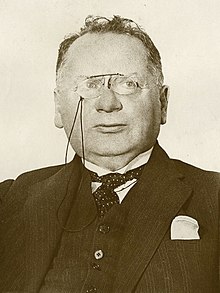This article may contain excessive or inappropriate references to self-published sources. (March 2023) |
This article may benefit from being shortened by the use of summary style. |
Maxim Litvinov | |
|---|---|
Максим Литвинов | |
 Litvinov in 1932 | |
| Russian Ambassador to the United States | |
| In office 10 November 1941 – 22 August 1943 | |
| Premier | Joseph Stalin |
| Preceded by | Konstantin Umansky |
| Succeeded by | Andrei Gromyko |
| In office 1918–1919 | |
| Premier | Vladimir Lenin |
| Preceded by | Boris Bakhmeteff |
| Succeeded by | Ludwig Martens |
| People's Commissar for Foreign Affairs of the Soviet Union | |
| In office 21 July 1930 – 3 May 1939 | |
| Premier | Alexei Rykov Vyacheslav Molotov |
| Preceded by | Georgy Chicherin |
| Succeeded by | Vyacheslav Molotov |
| Personal details | |
| Born | Meir Henoch Mojszewicz Wallach-Finkelstein 17 July 1876 Białystok, Russian Empire |
| Died | 31 December 1951 (aged 75) Moscow, Russian SFSR, Soviet Union |
| Nationality | Russian, Soviet |
| Political party | RSDLP (1898–1903) RSDLP (Bolsheviks) (1903–1918) Russian Communist Party (1918–1951) |
| Spouse | Ivy Litvinov |
| Profession | Diplomat, civil servant |
Maxim Maximovich Litvinov (Russian pronunciation: [mɐkˈsʲim mɐkˈsʲiməvʲɪtɕ lʲɪˈtvʲinəf]; born Meir Henoch Wallach-Finkelstein; 17 July 1876 – 31 December 1951) was a Russian revolutionary and prominent Soviet statesman and diplomat who served as People's Commissar for Foreign Affairs from 1930 to 1939.
Litvinov was an advocate for diplomatic agreements leading to disarmament, and was influential in making the Soviet Union a party to the 1928 Kellogg–Briand Pact. He was also responsible for the 1929 Litvinov Protocol, a multilateral agreement to implement the Kellogg-Briand Pact between the Soviet Union and several neighboring states.
In 1930, Litvinov was appointed People's Commissar of Foreign Affairs, the highest diplomatic position in the USSR. During the 1930s, Litvinov advocated the official Soviet policy of collective security with Western powers against Nazi Germany.[1]
- ^ "Maksim Litvinov". Encyclopaedia Britannica. 13 July 2023.